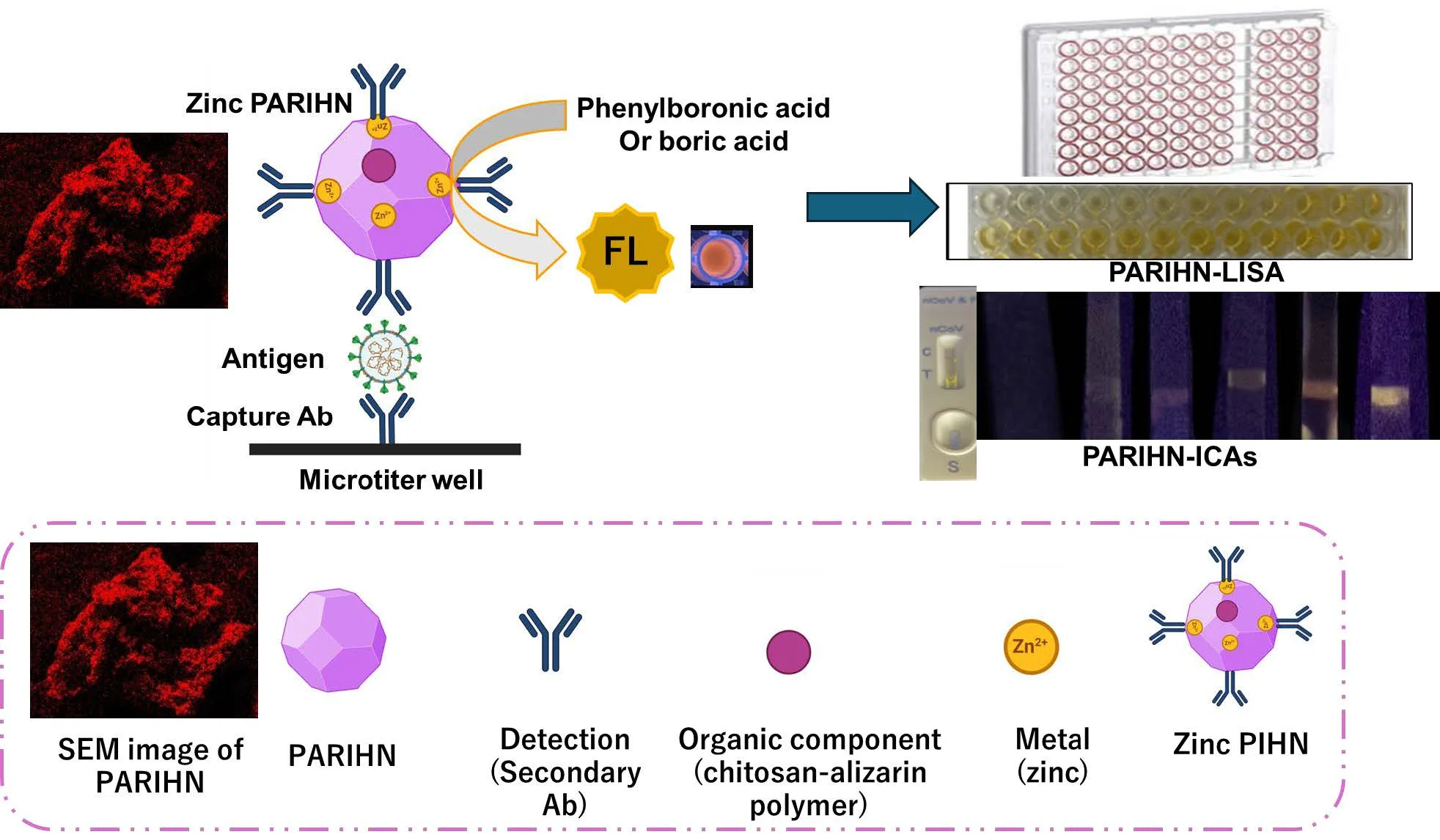

Proposing a New Corona Test Method that is Rapid, Highly Sensitive, Inexpensive, Environmentally Friendly, and 100 Times More Sensitive than Conventional Commercially Available Test Kits.
Professor Naoya Kishikawa and Professor Emeritus Naotaka Kuroda of the Department of Pharmaceutical Analytical Chemistry, Graduate School of Biomedical Sciences, Nagasaki University, in collaboration with Mansoura University, Egypt (Assoc. Prof. Mahmoud El-Maghrabey), have developed a polymerized alizarin red-inorganic hybrid nanoarchitecture (PARIHN).
PARIHN is a polymeric chitosan-based immunosorbent that is a highly sensitive immunoassay for SARS-CoV-2 nucleoprotein. PARIHN is a novel bio-derived nanoarchitecture based on chitosan, a natural polymer, and alizarin red, a natural dye, combined with zinc ions as inorganic components. This non-enzymatic fluorescent labeling technology replaces the enzymatic one commonly used in conventional immunoassays, thereby improving sensitivity, stability, and cost efficiency.
A fluorescence immunoassay using PARIHN was developed with ultrasensitivity for SARS-CoV-2 nucleoprotein down to 0.76 pM, which is approximately 10 times more sensitive than the conventional colorimetric immunoassay using the horseradish peroxidase enzyme (LOD, 7.88 pM).
Furthermore, PARIHN was applied to an immunochromatographic assay (ICA) for rapid testing of COVID-19, and its efficacy was confirmed. The sensitivity of the developed ICA was very high, reaching a detection limit of (9.45 pg/ml), which is 100 times more sensitive than commercially available AuNPs ICA strips. The PARIHN technology has demonstrated high sensitivity in immunoassays and immunochromatography, demonstrating its great potential as a diagnostic technology. To expand this technology from the R&D stage to practical use, optimisation of the manufacturing process to scale-up and cost reduction will be an important issue in the future.
Furthermore, combining PARIHN with microfluidic devices and point-of-care instruments will enable faster and simpler diagnosis and improve public health. In addition, research is underway to explore the possibility of adapting this technology to detect other pathogens and biomarkers to broaden its applications.

Jounal: Biosensors
Titile: Polymerized Alizarin Red–Inorganic Hybrid Nanoarchitecture (PARIHN) as a Novel Fluorogenic Label for the Immunosorbent Assay of COVID-19
Author:
Department of Analytical Chemistry for Pharmaceuticals, Course of Pharmaceutical Sciences, Graduate School of Biomedical Sciences, Nagasaki University, 1-14 Bunkyo-machi, Nagasaki 852-8521, Japan
Department of Pharmaceutical Analytical Chemistry, Faculty of Pharmacy, Mansoura University, Mansoura 35516, Egypt
Department of Analytical Chemistry for Pharmaceuticals, Course of Pharmaceutical Sciences, Graduate School of Biomedical Sciences, Nagasaki University, 1-14 Bunkyo-machi, Nagasaki 852-8521, Japan
Department of Pharmaceutical Analytical Chemistry, Faculty of Pharmacy, Mansoura University, Mansoura 35516, Egypt
Department of Analytical Chemistry for Pharmaceuticals, Course of Pharmaceutical Sciences, Graduate School of Biomedical Sciences, Nagasaki University, 1-14 Bunkyo-machi, Nagasaki 852-8521, Japan
DOI: https://doi.org/10.3390/bios15040256
Publication Date: 16 April 2025
For more details, please see the full article on Nagasaki University’s Academic Output SITE.